Use of Simulated Sunlight Radiation and Hydrogen Peroxide to Remove Xenobiotics from Aqueous Solutions
Abstract
:1. Introduction
2. Materials and Methods
2.1. Chemicals
2.2. Preliminary Experiments—Direct Oxidation
2.3. Photolysis
2.4. Experimental Design
2.5. Chemical Analysis
2.6. Toxicity
3. Results and Discussion
3.1. Photolysis and Toxicity
3.1.1. Acetamiprid
3.1.2. Clothianidin
3.1.3. Thiacloprid
3.2. Direct Oxidation with Hydrogen Peroxide
3.3. Photolysis in the Presence of Hydrogen Peroxide
3.3.1. Acetamiprid
3.3.2. Clothianidin
3.3.3. Thiacloprid
4. Conclusions
Supplementary Materials
Author Contributions
Funding
Data Availability Statement
Conflicts of Interest
References
- Commoner, B.; Corr, M.; Stamler, P.J. The Causes of Pollution. Environment 1971, 13, 2–19. [Google Scholar] [CrossRef]
- Dokić, M.; Bilandžić, N.; Briški, F. Postupci Uklanjanja Pesticida Iz Okoliša. Kem. Ind. Chem. Chem. Eng. 2012, 61, 341–348. [Google Scholar]
- Fetzner, S. Biodegradation of Xenobiotics. In Encyclopedia of Life Support Systems (EOLSS) Publishers, Developed under the Auspices of the UNESCO; Biotechnology; EOLSS: Oxford, UK, 2002; Volume 10, pp. 1–8. [Google Scholar]
- Raman Suri, C.; Boro, R.; Nangia, Y.; Gandhi, S.; Sharma, P.; Wangoo, N.; Rajesh, K.; Shekhawat, G.S. Immunoanalytical Techniques for Analyzing Pesticides in the Environment. TrAC Trends Anal. Chem. 2009, 28, 29–39. [Google Scholar] [CrossRef]
- Büttner, O.; Jawitz, J.W.; Birk, S.; Borchardt, D. Why Wastewater Treatment Fails to Protect Stream Ecosystems in Europe. Water Res. 2022, 217, 118382. [Google Scholar] [CrossRef] [PubMed]
- Hakeem, K.R.; Akhtar, M.S.; Abdullah, S.N.A. Plant, Soil and Microbes: Volume 1: Implications in Crop Science; Springer: Dordrecht, The Netherlands, 2016; pp. 1–366. [Google Scholar] [CrossRef]
- Aktar, W.; Sengupta, D.; Chowdhury, A. Impact of Pesticides Use in Agriculture: Their Benefits and Hazards. Interdiscip. Toxicol. 2009, 2, 1–12. [Google Scholar] [CrossRef] [PubMed]
- Rasool, S.; Rasool, T.; Gani, K.M. A Review of Interactions of Pesticides within Various Interfaces of Intrinsic and Organic Residue Amended Soil Environment. Chem. Eng. J. Adv. 2022, 11, 100301. [Google Scholar] [CrossRef]
- Maurya, P.K.; Malik, D.S. Bioaccumulation of Xenobiotics Compound of Pesticides in Riverine System and Its Control Technique: A Critical Review. J. Ind. Pollut. Control 2016, 32, 580–594. [Google Scholar]
- Zaller, J.G.; Kruse-Plaß, M.; Schlechtriemen, U.; Gruber, E.; Peer, M.; Nadeem, I.; Formayer, H.; Hutter, H.P.; Landler, L. Pesticides in Ambient Air, Influenced by Surrounding Land Use and Weather, Pose a Potential Threat to Biodiversity and Humans. Sci. Total Environ. 2022, 838, 156012. [Google Scholar] [CrossRef]
- Acero, J.L.; Real, F.J.; Javier Benitez, F.; Matamoros, E. Degradation of Neonicotinoids by UV Irradiation: Kinetics and Effect of Real Water Constituents. Sep. Purif. Technol. 2019, 211, 218–226. [Google Scholar] [CrossRef]
- Wood, T.J.; Goulson, D. The Environmental Risks of Neonicotinoid Pesticides: A Review of the Evidence Post 2013. Environ. Sci. Pollut. Res. 2017, 24, 17285–17325. [Google Scholar] [CrossRef]
- Gibbons, D.; Morrissey, C.; Mineau, P. A Review of the Direct and Indirect Effects of Neonicotinoids and Fipronil on Vertebrate Wildlife. Environ. Sci. Pollut. Res. 2015, 22, 103–118. [Google Scholar] [CrossRef] [PubMed]
- Forrester, M.B. Neonicotinoid Insecticide Exposures Reported to Six Poison Centers in Texas. Hum. Exp. Toxicol. 2014, 33, 568–573. [Google Scholar] [CrossRef] [PubMed]
- Schaafsma, A.; Limay-Rios, V.; Baute, T.; Smith, J.; Xue, Y. Neonicotinoid Insecticide Residues in Surface Water and Soil Associated with Commercial Maize (Corn) Fields in Southwestern Ontario. PLoS ONE 2015, 10, e0118139. [Google Scholar] [CrossRef] [PubMed]
- Sadaria, A.M.; Supowit, S.D.; Halden, R.U. Mass Balance Assessment for Six Neonicotinoid Insecticides during Conventional Wastewater and Wetland Treatment: Nationwide Reconnaissance in United States Wastewater. Environ. Sci. Technol. 2016, 50, 6199–6206. [Google Scholar] [CrossRef]
- Sánchez-Bayo, F.; Hyne, R.V. Detection and Analysis of Neonicotinoids in River Waters—Development of a Passive Sampler for Three Commonly Used Insecticides. Chemosphere 2014, 99, 143–151. [Google Scholar] [CrossRef] [PubMed]
- Klarich, K.L.; Pflug, N.C.; DeWald, E.M.; Hladik, M.L.; Kolpin, D.W.; Cwiertny, D.M.; LeFevre, G.H. Occurrence of Neonicotinoid Insecticides in Finished Drinking Water and Fate during Drinking Water Treatment. Environ. Sci. Technol. Lett. 2017, 4, 168–173. [Google Scholar] [CrossRef]
- Barbosa, M.O.; Moreira, N.F.F.; Ribeiro, A.R.; Pereira, M.F.R.; Silva, A.M.T. Occurrence and Removal of Organic Micropollutants: An Overview of the Watch List of EU Decision 2015/495. Water Res. 2016, 94, 257–279. [Google Scholar] [CrossRef]
- Wols, B.A.; Hofman-Caris, C.H.M. Review of Photochemical Reaction Constants of Organic Micropollutants Required for UV Advanced Oxidation Processes in Water. Water Res. 2012, 46, 2815–2827. [Google Scholar] [CrossRef]
- De Souza, R.M.; Seibert, D.; Quesada, H.B.; de Jesus Bassetti, F.; Fagundes-Klen, M.R.; Bergamasco, R. Occurrence, Impacts and General Aspects of Pesticides in Surface Water: A Review; Elsevier: Amsterdam, The Netherlands, 2020; Volume 135, ISBN 5545337970. [Google Scholar]
- Carlson, J.C.; Stefan, M.I.; Parnis, J.M.; Metcalfe, C.D. Direct UV Photolysis of Selected Pharmaceuticals, Personal Care Products and Endocrine Disruptors in Aqueous Solution. Water Res. 2015, 84, 350–361. [Google Scholar] [CrossRef]
- Peña, A.; Rodríguez-Liébana, J.A.; Mingorance, M.D. Persistence of Two Neonicotinoid Insecticides in Wastewater, and in Aqueous Solutions of Surfactants and Dissolved Organic Matter. Chemosphere 2011, 84, 464–470. [Google Scholar] [CrossRef]
- Lu, Z.; Challis, J.K.; Wong, C.S. Quantum Yields for Direct Photolysis of Neonicotinoid Insecticides in Water: Implications for Exposure to Nontarget Aquatic Organisms. Environ. Sci. Technol. Lett. 2015, 2, 188–192. [Google Scholar] [CrossRef]
- Cano, P.A.; Jaramillo-Baquero, M.; Zúñiga-Benítez, H.; Londoño, Y.A.; Peñuela, G.A. Use of Simulated Sunlight Radiation and Hydrogen Peroxide in Azithromycin Removal from Aqueous Solutions: Optimization & Mineralization Analysis. Emerg. Contam. 2020, 6, 53–61. [Google Scholar] [CrossRef]
- Pelayo, D.; Rivero, M.J.; Santos, G.; Gómez, P.; Ortiz, I. Techno-Economic Evaluation of UV Light Technologies in Water Remediation. Sci. Total Environ. 2023, 868, 161376. [Google Scholar] [CrossRef]
- Kurwadkar, S.; Evans, A.; DeWinne, D.; White, P.; Mitchell, F. Modeling Photodegradation Kinetics of Three Systemic Neonicotinoids—Dinotefuran, Imidacloprid, and Thiamethoxam—In Aqueous and Soil Environment. Environ. Toxicol. Chem. 2016, 35, 1718–1726. [Google Scholar] [CrossRef]
- Dell’Arciprete, M.L.; Santos-Juanes, L.; Sanz, A.A.; Vicente, R.; Amat, A.M.; Furlong, J.P.; Mártire, D.O.; Gonzalez, M.C. Reactivity of Hydroxyl Radicals with Neonicotinoid Insecticides: Mechanism and Changes in Toxicity. Photochem. Photobiol. Sci. 2009, 8, 1016–1023. [Google Scholar] [CrossRef]
- Yin, K.; Deng, Y.; Liu, C.; He, Q.; Wei, Y.; Chen, S.; Liu, T.; Luo, S. Kinetics, Pathways and Toxicity Evaluation of Neonicotinoid Insecticides Degradation via UV/Chlorine Process. Chem. Eng. J. 2018, 346, 298–306. [Google Scholar] [CrossRef]
- Li, H.; Duan, L.; Wang, H.; Chen, Y.; Wang, F.; Zhang, S. Photolysis of Sulfadiazine under UV Radiation: Effects of the Initial Sulfadiazine Concentration, PH, NO3− and Cd2+. Chem. Phys. Lett. 2020, 739, 136949. [Google Scholar] [CrossRef]
- Babić, B.; Andrić, D.; Farkaš, A.; Vuk, D.; Ašperger, D.; Dolar, D. Behavior of Mebendazole during NF/RO Adsorption and Photolysis. Membranes 2022, 12, 888. [Google Scholar] [CrossRef]
- ISO 11348-1:2007; Water Quality—Determination of the Inhibitory Effect of Water Samples on the Light Emission of Vibrio Fischeri (Luminescent Bacteria Test)—Part 1: Method Using Freshly Prepared Bacteria. ISO: Geneva, Switzerland, 2007.
- DIN 38412-341; Examination of Water, Waste Water and Sluge; Bio-Assays (Group L) Determination of the Inhibitory Effect of Waste Water on the Lightemission of Photobacterium Phosphoreum (L34) Preparation of Test Suspensions (L341). Deutsches Institut Fur Normung E.V. (German National Standard): Berlin, Germany, 1994.
- Chen, L.; Cai, T.; Cheng, C.; Xiong, Z.; Ding, D. Degradation of Acetamiprid in UV/H2O2 and UV/Persulfate Systems: A Comparative Study. Chem. Eng. J. 2018, 351, 1137–1146. [Google Scholar] [CrossRef]
- Li, Y.; Su, P.; Li, Y.; Wen, K.; Bi, G.; Cox, M. Adsorption-Desorption and Degradation of Insecticides Clothianidin and Thiamethoxam in Agricultural Soils. Chemosphere 2018, 207, 708–714. [Google Scholar] [CrossRef]
- Abramović, B.F.; Banić, N.D.; Šojić, D.V. Degradation of Thiacloprid in Aqueous Solution by UV and UV/H2O2 Treatments. Chemosphere 2010, 81, 114–119. [Google Scholar] [CrossRef]
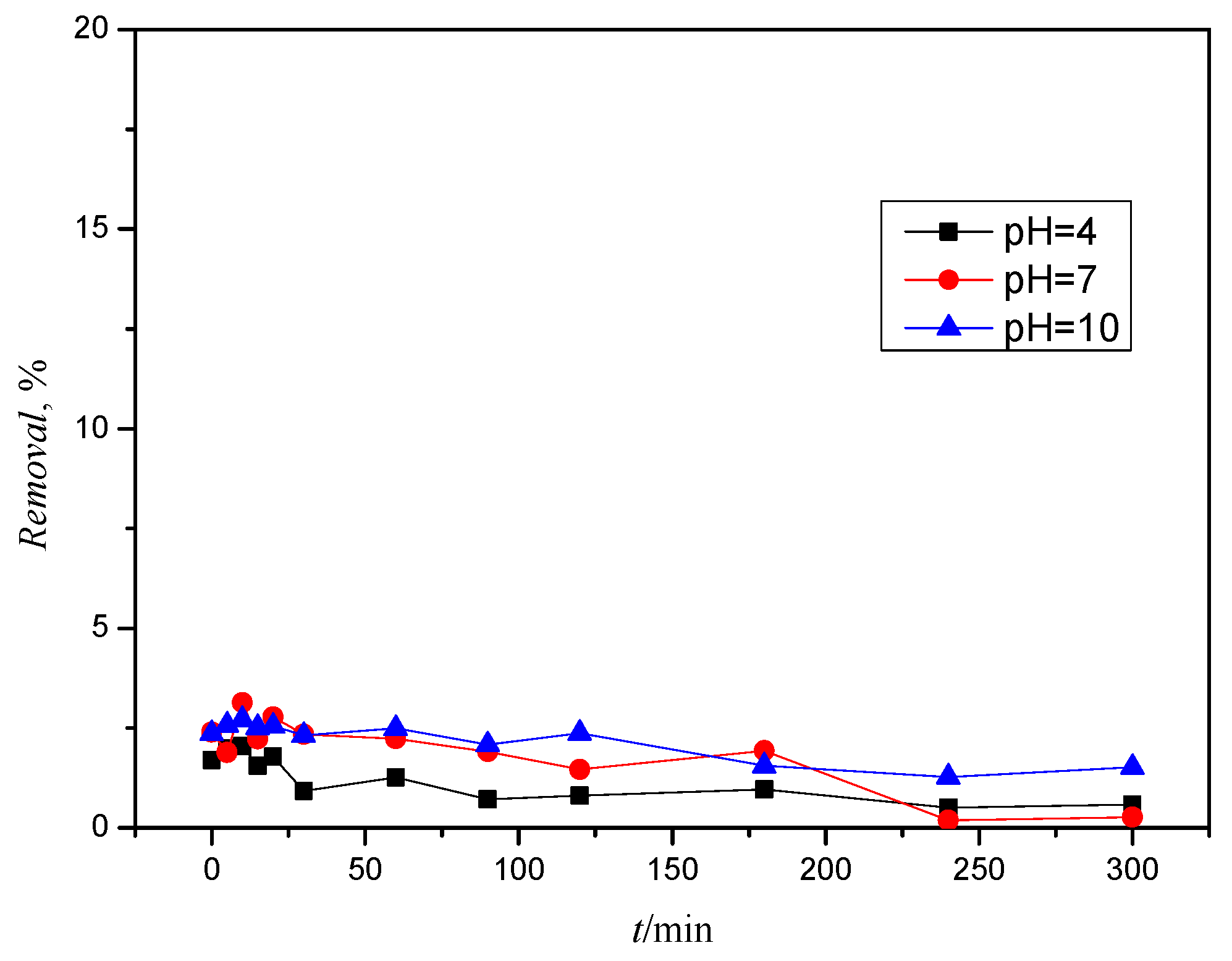

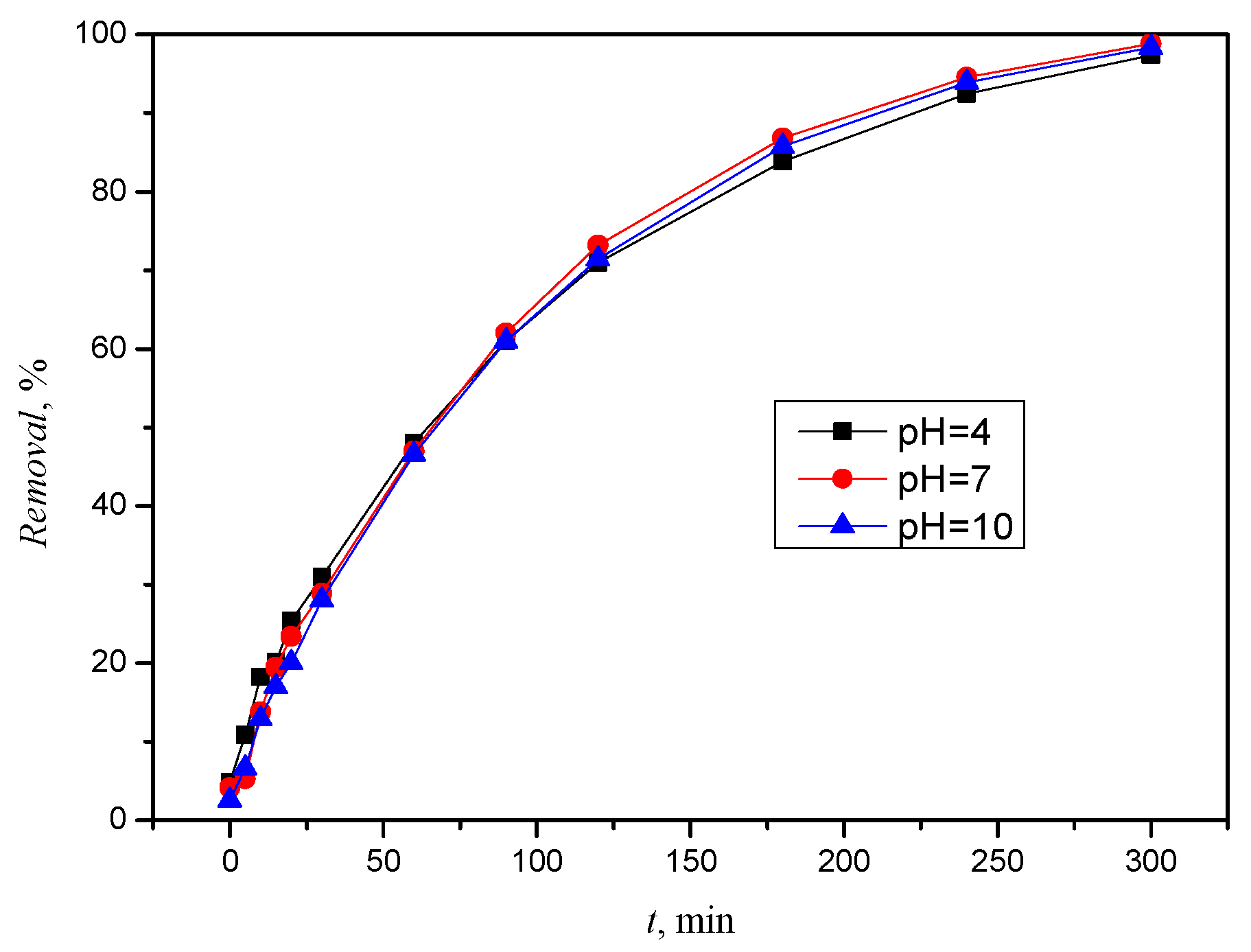
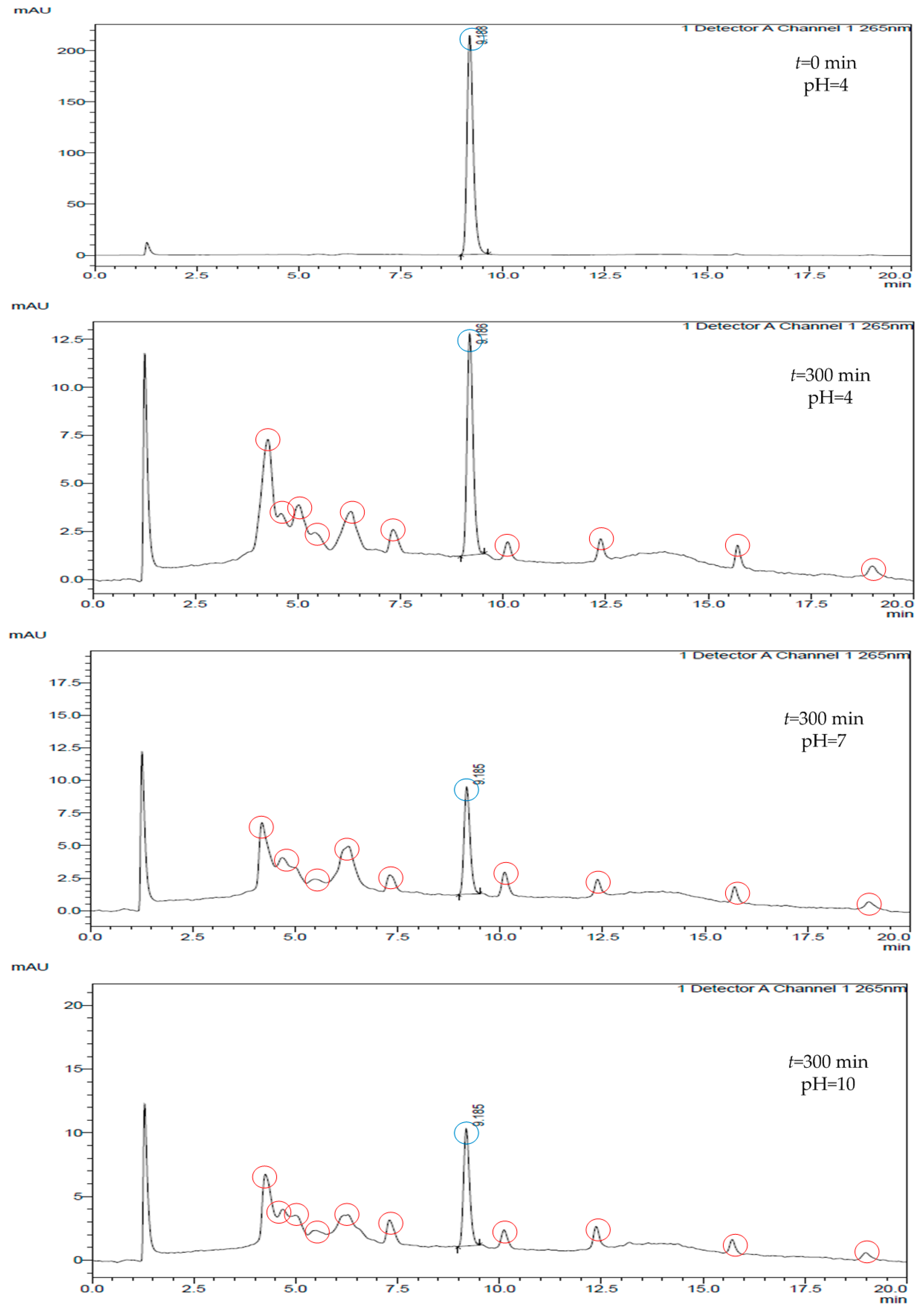
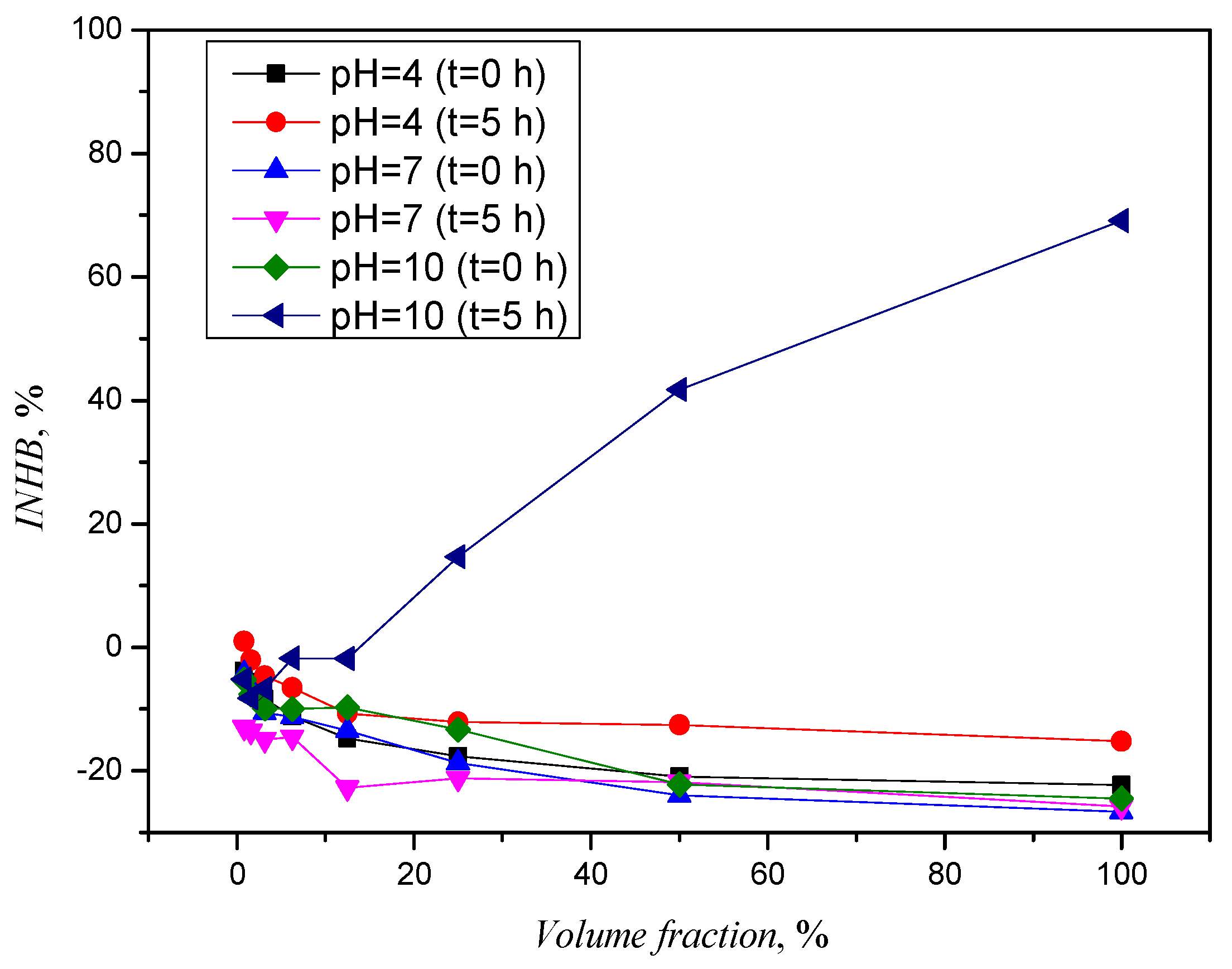
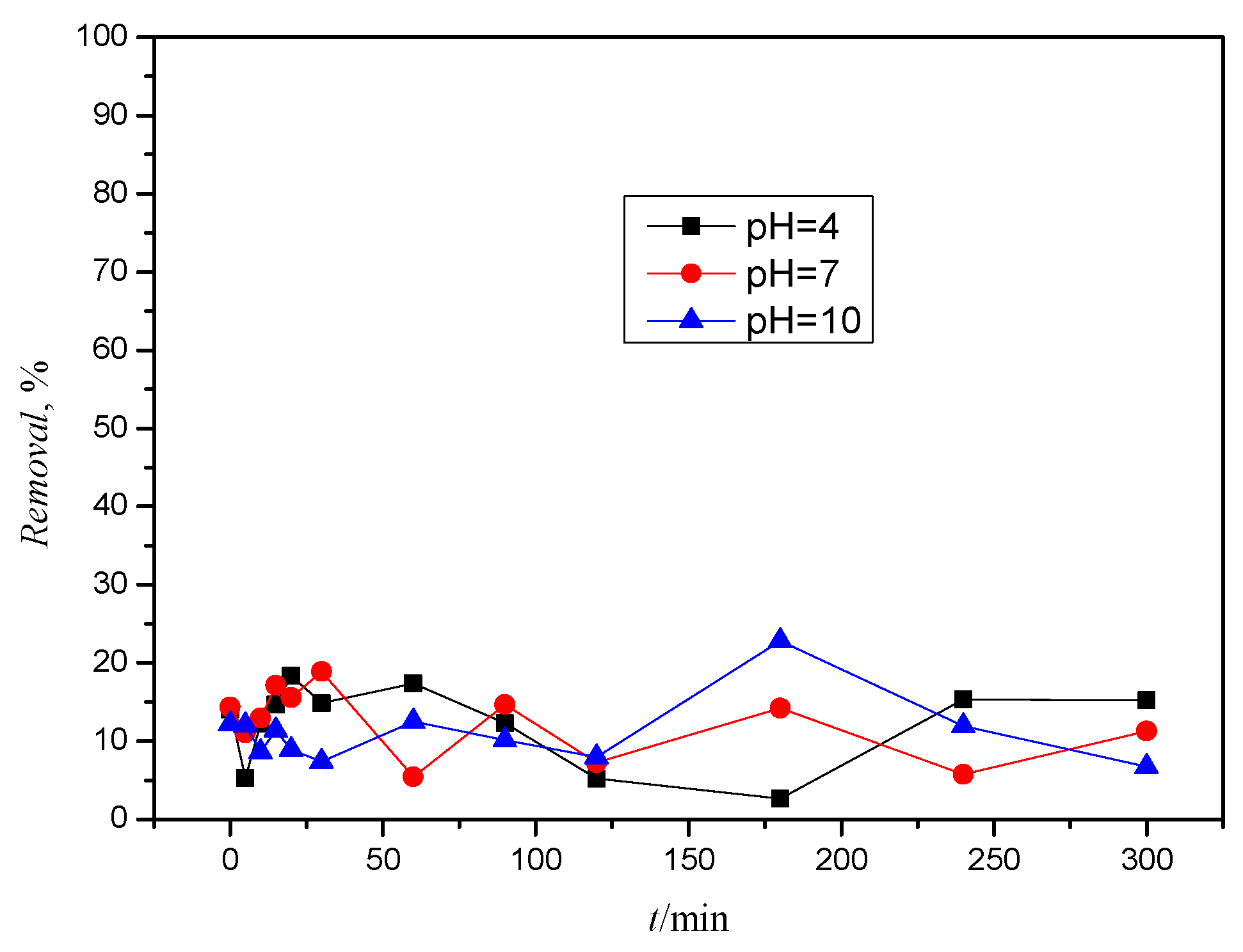


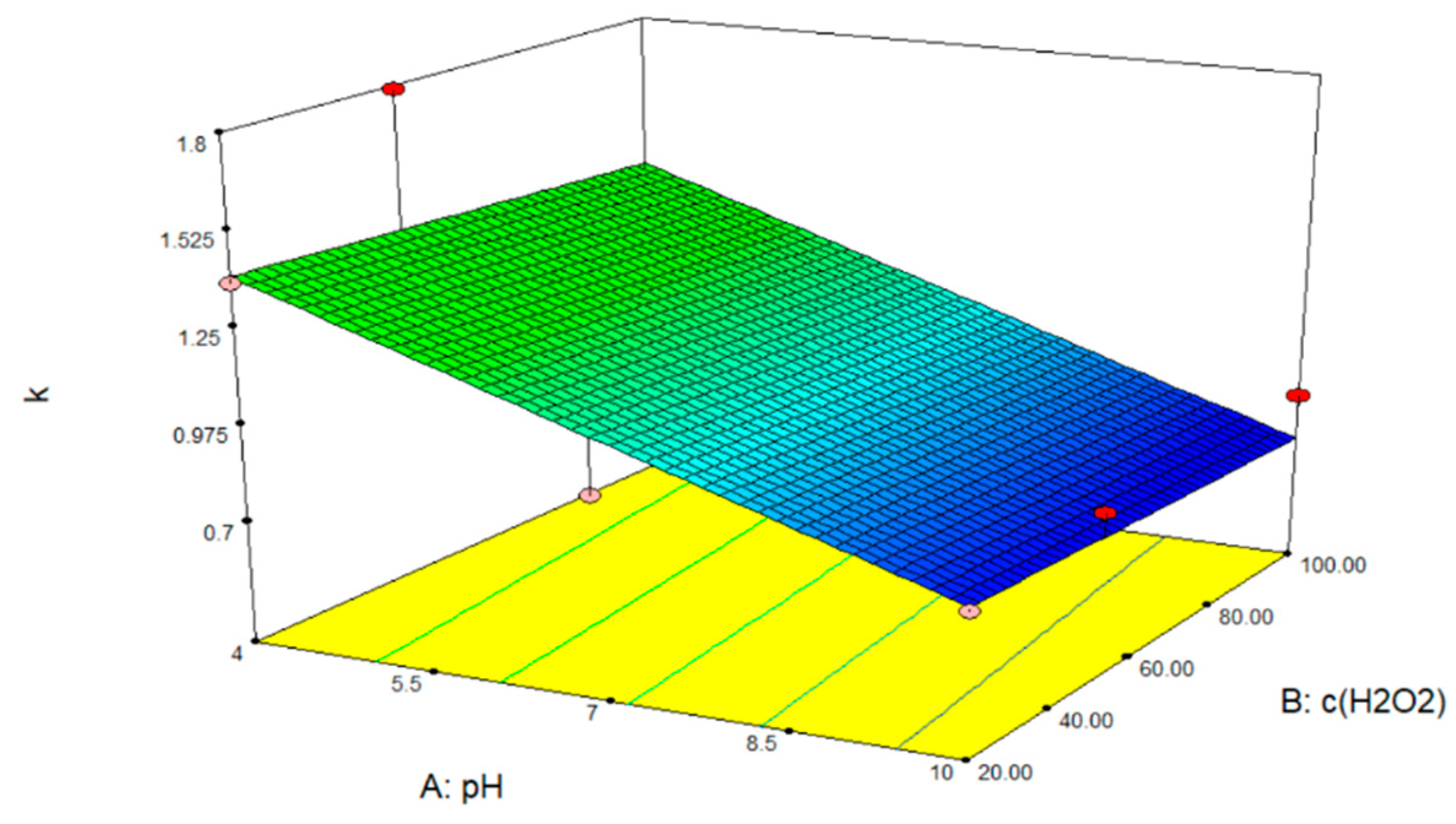




| Name | Acetamiprid | Clothianidin | Thiacloprid |
|---|---|---|---|
| CAS number | 135410-20-7 | 210880-92-5 | 111988-49-9 |
| Mw (g/mol) | 222.67 | 249.68 | 252.72 |
| Molecular structures |  |  | 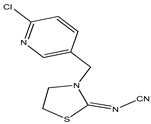 |
| 3 logKow | 2.55 1 | 0.70 1 | 2.33 1 |
| pKa | - | 11.1 2 | - |
| tt (°C) | 106.78 1 | 146.49 1 | 150.44 1 |
| tv (°C) | 339.97 1 | 363.86 1 | 383 1 |
| 4S (mg/L) | 222.6 1 | 5997 1 | 231.9 1 |
| Factor | Low Level | Medium Level | High Level |
|---|---|---|---|
| H2O2 initial concentration (mM) | 20 | 50 | 100 |
| pH value | 4.0 | 7.0 | 10.0 |
| c(H2O2), mM | pH | k | R2 |
|---|---|---|---|
| 20 | 4 | 1.3828 | 0.9901 |
| 20 | 7 | 0.9193 | 0.9885 |
| 20 | 10 | 0.7515 | 0.9586 |
| 50 | 4 | 1.7865 | 0.9792 |
| 50 | 7 | 0.9000 | 0.9912 |
| 50 | 10 | 0.8101 | 0.9919 |
| 100 | 4 | 1.1463 | 0.9983 |
| 100 | 7 | 0.9751 | 0.9990 |
| 100 | 10 | 0.8360 | 0.9991 |
| c(H2O2), mM | pH | k | R2 |
|---|---|---|---|
| 20 | 4 | 2.9407 | 0.8898 |
| 20 | 7 | 1.9808 | 0.9488 |
| 20 | 10 | 1.6418 | 0.9308 |
| 50 | 4 | 3.3788 | 0.9527 |
| 50 | 7 | 2.6954 | 0.9809 |
| 50 | 10 | 1.6418 | 0.9642 |
| 100 | 4 | 4.1842 | 0.9909 |
| 100 | 7 | 3.7248 | 0.9624 |
| 100 | 10 | 2.0616 | 0.9878 |
| c(H2O2), mM | pH | k | R2 |
|---|---|---|---|
| 20 | 4 | 1.3330 | 0.9914 |
| 20 | 7 | 0.7480 | 0.9845 |
| 20 | 10 | 0.7279 | 0.9502 |
| 50 | 4 | 1.2917 | 0.9861 |
| 50 | 7 | 1.0739 | 0.9816 |
| 50 | 10 | 0.7588 | 0.9051 |
| 100 | 4 | 1.9954 | 0.9786 |
| 100 | 7 | 1.5564 | 0.9860 |
| 100 | 10 | 1.1502 | 0.9983 |
Disclaimer/Publisher’s Note: The statements, opinions and data contained in all publications are solely those of the individual author(s) and contributor(s) and not of MDPI and/or the editor(s). MDPI and/or the editor(s) disclaim responsibility for any injury to people or property resulting from any ideas, methods, instructions or products referred to in the content. |
© 2023 by the authors. Licensee MDPI, Basel, Switzerland. This article is an open access article distributed under the terms and conditions of the Creative Commons Attribution (CC BY) license (https://creativecommons.org/licenses/by/4.0/).
Share and Cite
Babić Visković, B.; Maslač, A.; Dolar, D.; Ašperger, D. Use of Simulated Sunlight Radiation and Hydrogen Peroxide to Remove Xenobiotics from Aqueous Solutions. Processes 2023, 11, 3403. https://doi.org/10.3390/pr11123403
Babić Visković B, Maslač A, Dolar D, Ašperger D. Use of Simulated Sunlight Radiation and Hydrogen Peroxide to Remove Xenobiotics from Aqueous Solutions. Processes. 2023; 11(12):3403. https://doi.org/10.3390/pr11123403
Chicago/Turabian StyleBabić Visković, Bruna, Anamaria Maslač, Davor Dolar, and Danijela Ašperger. 2023. "Use of Simulated Sunlight Radiation and Hydrogen Peroxide to Remove Xenobiotics from Aqueous Solutions" Processes 11, no. 12: 3403. https://doi.org/10.3390/pr11123403







